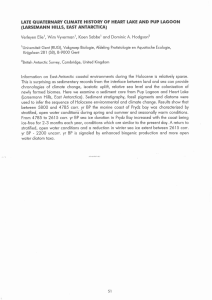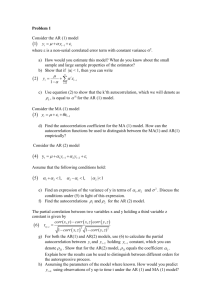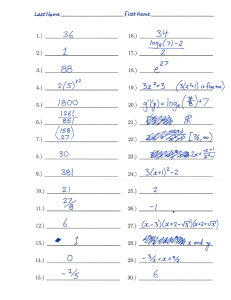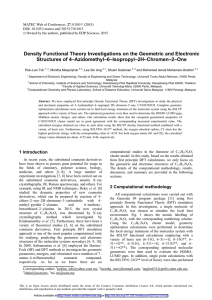10.675 LECTURE 13 1. Today →
advertisement
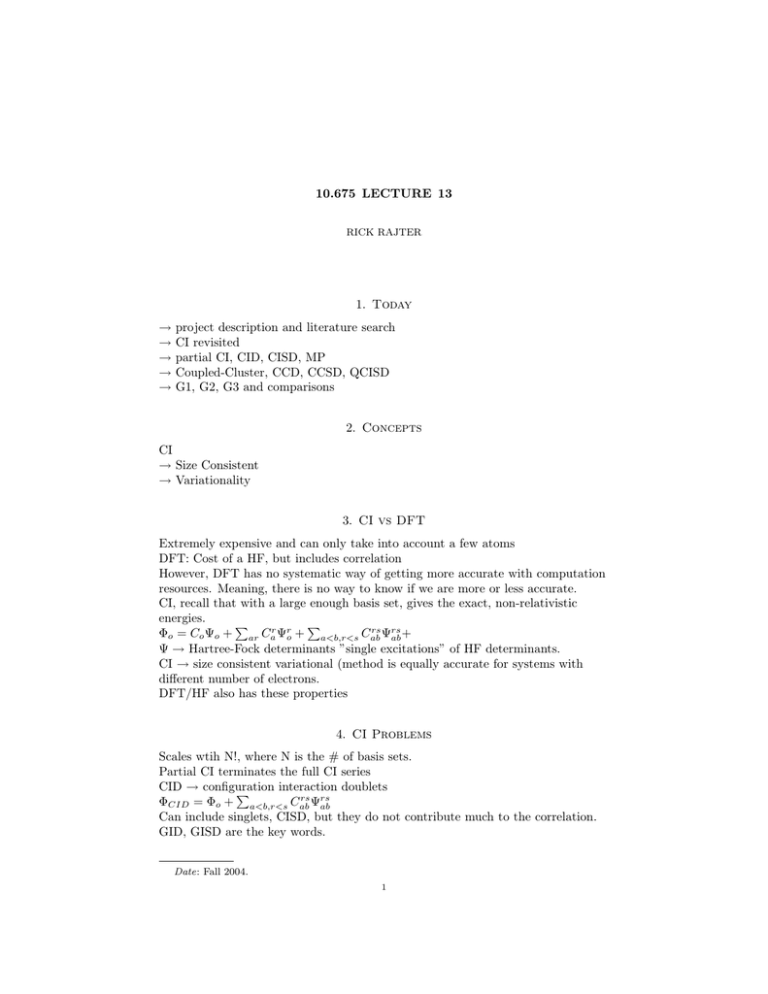
10.675 LECTURE 13 RICK RAJTER 1. Today → → → → → project description and literature search CI revisited partial CI, CID, CISD, MP Coupled­Cluster, CCD, CCSD, QCISD G1, G2, G3 and comparisons 2. Concepts CI → Size Consistent → Variationality 3. CI vs DFT Extremely expensive and can only take into account a few atoms DFT: Cost of a HF, but includes correlation However, DFT has no systematic way of getting more accurate with computation resources. Meaning, there is no way to know if we are more or less accurate. CI, recall that with a large enough basis set, gives the exact, non­relativistic energies. � � rs rs Ψab + Φo = Co Ψo + ar Car Ψro + a<b,r<s Cab Ψ → Hartree­Fock determinants ”single excitations” of HF determinants. CI → size consistent variational (method is equally accurate for systems with different number of electrons. DFT/HF also has these properties 4. CI Problems Scales wtih N!, where N is the # of basis sets. Partial CI terminates the full CI series interaction doublets CID → configuration � rs rs ΦCID = Φo + a<b,r<s Cab Ψab Can include singlets, CISD, but they do not contribute much to the correlation. GID, GISD are the key words. Date: Fall 2004. 1 2 RICK RAJTER 5. CID HΦCID = �CID ΦCID subtract Eo ΦCID Eo is the HF energy. Corr (H − Eo )ΦCID = (�CID − Eo )ΦCID = ECID ΦCID Multiply by Φ and intergrate. � � Corr rs = ECID Φo HΨrs a < b, r < sCab ab � dr tu � tu � rs Ψcd (H − Eo )Ψrs HΨ and integrate Ψ Mult by Ψtu o dr + ab cd cd a<b,r<s Cab tu corr = Ccd Ecd Corr Can use these equations to find ECID (similarly w/CISD) Variational and NOT size consistent A and B in separate cells vs AB Calculate as separation goes to ∞ corr corr corr | + EB | < |EA |EA∞B A||B double excitations in both A ↔ B double excitations of the entire system., but not double excitations of A AND B together. Extreme Case, XL system (infinite) Corr per atom → 0. ECID 6. MP → are size consistent → Not variational → convergence slow with respect to terms in perturbation. 7. Coupled Cluster Method Approximations Ignore singlet/triplet/etc excitations from CI wavefunction � �r<s<t<u rstu rstu rs Φcc a < b, r < scrs o = Ψo + ab Ψab + a<b<c<d cabcd Φabcd One can show that higher order coefficients rstu rs tu Cabcd Cab ∗ Ccd where * means the summation of the products of the doublets �r<s † † a Φcc = exp(τ )Φo , τ = a<b crs ab r as ab aa Where the terms on the right are the creation/annihilation operators CCD → coupled clusters w/doublets 8. CCSD There is a way to incorporate single excitations ⇒ → size consistent → not variational QCISD is quadratic configuration, similar to coupled cluster methods CCSD → seen as the ”gold standard” from the chemists community. Tolerance of 1 Kcal/mole, which is the best we’ll get. 9. G1,G2 methods G1, G2 methods → composite method for computing energies and enthalpies of molecules NEED 1) Geometry Equilibrium 2) Total Electronic Energy 3) Harmonic Frequencies 10.675 LECTURE 13 3 Outline for G1 I Optimize geometry (restriced HF/6­31G*) II Use equilibrium geometries from I, optimize again w/MP2/6­31G* III Perform MP4 SDTQ, 6­31G** on valence electrons only IV incorporate effects of better basis sets for diffuse sp functions ΔE(t) = E(M P 4/6 − 311 + G ∗ ∗) − E(M P 4/6 − 311G ∗ ∗) V Correct for additional polarization functions on non­H atoms ΔE(sdf ) = E(M P 4/6 − 311G ∗ ∗(2df )) − E(M P 4/6 − 311G ∗ ∗) VI Correct for additional correlation effects ΔE(QCI) = E(QCISD(+))/6 − 31G ∗ ∗ − E(M P 4/6 − 311G ∗ ∗) VII E(combined) = E(MP4/6­311G**) + Δ E(t) + Δ E(2df) + Δ E (QCI) VIII HLC (higher order correlation) ΔE (HLC) = ­5.95 Nβ ­ 0.19 Nα Nα > Nβ in milli­hartrees Numbers were chosen, so that Ee is exact for H atom and H2 . Ec = Ecombined + ΔE(HLC) IX Calc Frequencies at HF/6­31G* and scaled by 0.893 ⇒ ZPE zero point energy X Eo = Ee + Δ(ZP E) o , ΔHfo , etc also calculate ΔHrxn 10. G2 I. Additional basis set correction II. Correction to GI for a third d function to non­H, p function to H. Δ2 E[M P 2/6 − 311 + G(3df, 2d] − E[M P 2/6 − 311 + G(2df, p)] III correction to atomization energies of 55 molecules w/well established experimental values.


